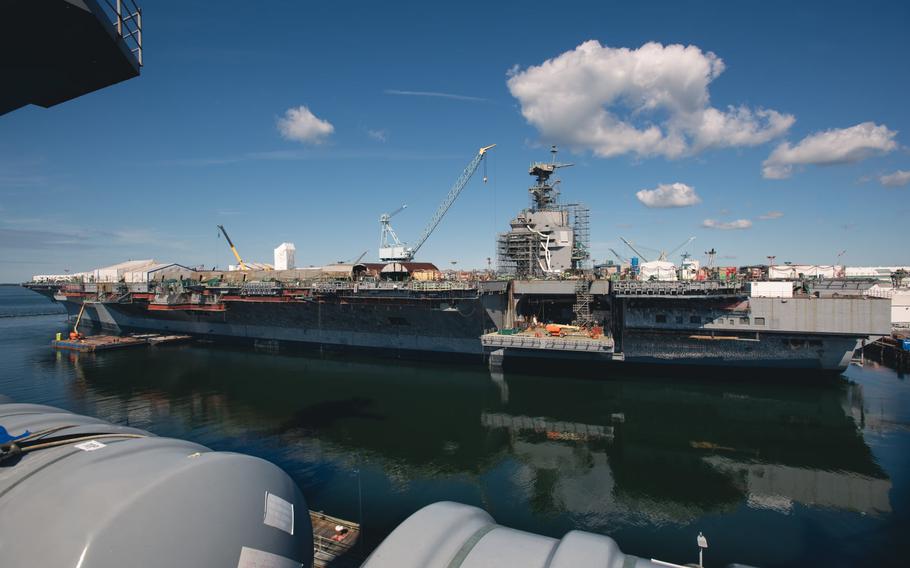
The future John F. Kennedy as seen from the flight deck of USS Gerald R. Ford at Newport News Shipbuilding in Virginia in January 2022. The aircraft carrier will not be delivered until March 2027, the Navy said. It had been scheduled to join the fleet this year, according to Navy budget estimates. (Facebook/HHI)
A projected two-year delay in bringing the Navy’s newest aircraft carrier to the fleet will eventually leave the service with just 10 carriers for nearly a year, according to Navy budget documents.
The future USS John F. Kennedy was scheduled to join the fleet this month but now isn’t on track for delivery until March 2027, according to the Navy’s 2026 budget estimates.
It’s unclear how the delay could affect the service amid intensive operations in multiple theaters, including the Asia-Pacific, eastern Mediterranean Sea and Middle East.
Two carriers, USS Nimitz and USS Carl Vinson, currently are in the Middle East, USNI News reported on Monday. A third, USS Gerald R. Ford, left for deployment in late June to the U.S. 6th Fleet area of operations, which includes the eastern Mediterranean.
There are 11 active aircraft carriers in service, with Nimitz scheduled to be decommissioned in May 2026, USNI news reported in March.
Construction on Kennedy, the second ship of the Ford-class carriers, began in February 2011. The ship is designated CVN 79.
The delay is needed to finish advanced arresting gear certification and complete work on the advanced weapons elevator, the Navy said in a budget footnote.
Arresting gear rapidly decelerates an aircraft when it lands on an aircraft carrier. The elevators move large amounts of weapons to the hangar bay and flight deck to allow for faster rearming of aircraft.
Nimitz, which was commissioned in 1975, had its service life extended amid Ford-class carrier delays. It was scheduled to be deactivated this year.
Ford made its maiden deployment in 2022 after significant cost overruns, technical issues and other delays following its 2017 commissioning as the lead ship of its class.
Since then, the carrier completed a more than eight-month deployment that included the eastern Mediterranean Sea and Middle East in January 2024.
With Nimitz-class carriers reaching the end of their service lives, fielding their Ford-class replacements in a timely manner is imperative, Maya Carlin, an analyst with the Washington, D.C.-based think tank Center for Security Policy, wrote in The National Interest in April.
“While rising costs associated with shipbuilding are stalling progress on the Fords’ arrivals, prioritizing a next-generation carrier class will support America’s national security and foreign policy objectives,” Carlin said.
In April, Navy officials told members of a Senate subcommittee that the service and CVN 79 builder HII-Newport News Shipbuilding were “hyper-focused” on the fastest path to a combat-ready ship, crew and air wing. They also said construction on CVN 79 was about 95% complete.
But while initial design problems encountered during construction of Ford were resolved, “early class production-focused challenges and associated learning continue on CVN 79,” the service said in its congressional testimony.
Lessons learned are being used in the construction of two other carriers, including the future USS Enterprise, or CVN 80, which was estimated to be about 44% complete, the officials said.
The delivery date of CVN 80 was pushed back as well, from September 2029 to July 2030, according to the budget documents.